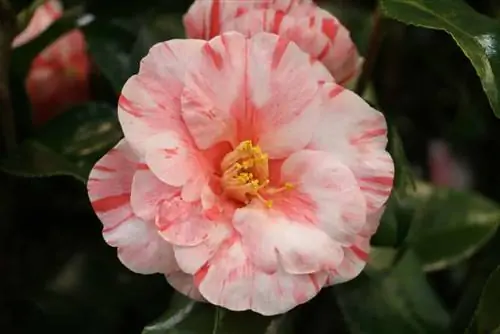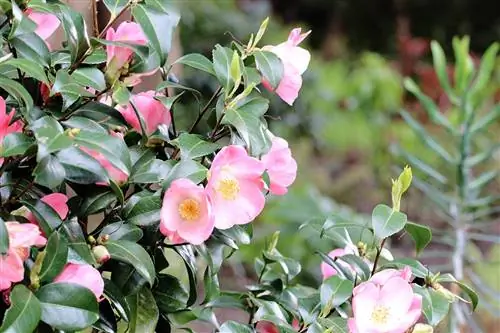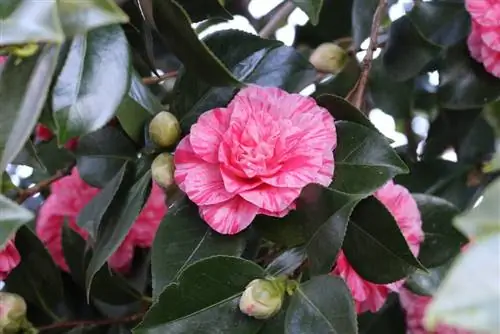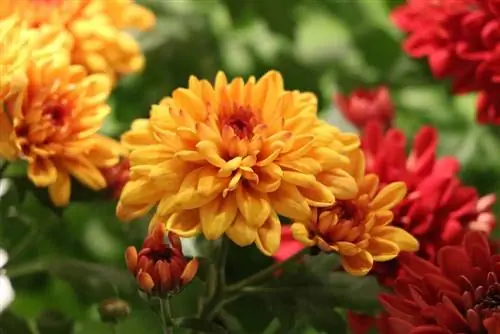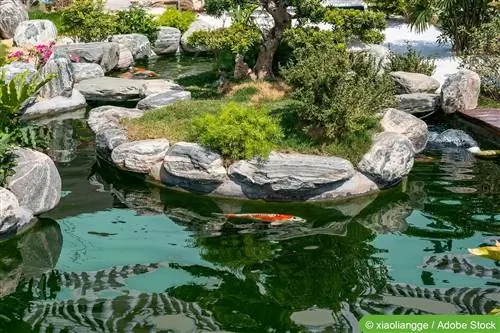- Author admin [email protected].
- Public 2023-12-17 03:39.
- Last modified 2025-06-01 06:48.
The wine-growing climate is particularly suitable for this. It is important to select varieties that are characterized by high winter hardiness. Leaf frostbite can also occur, but these usually grow back out. In addition, only late-flowering varieties should be planted because the flowers freeze at temperatures just a few degrees below zero. Otherwise, the care is quite uncomplicated.
Short profile of the Camelia plants
- Tea plant family
- Come from East Asia
- Cultivated plant that is thousands of years old in China and Japan
- Over 200 species and 30,000 varieties
- Evergreen shrub or small tree
- Can grow to between 1.5 and 6 m high, but with us they stay smaller
- Short-stemmed flowers, singly or in pairs
- Flowers, depending on the variety, in white, pink to red, also multicolored
- Different flower shapes
- Differences also in growth and leaf shape
- Flowering in Central Europe in late winter or spring
- Scents of different strengths
- Fruits from September, October
Caring for Camellia
First you have to distinguish whether it is a potted plant or a planted specimen. However, both require cool temperatures for the flower buds to open. At low temperatures the flowers last for weeks, but in a warm living room they only last a few days. Regardless of whether it is planted out or cultivated in a container, the demands on the substrate are the same. The plants prefer humus-rich, loose and slightly acidic soil. Outdoors, camellias need to be protected from cold easterly winds and sun, especially in winter. A partially shaded location is ideal. Regular water supply is important. The plants do not suffer from drought or waterlogging. Potted plants also need additional nutrients. Planted specimens usually get by without it. Camellias tolerate pruning, but do not necessarily need to be pruned. However, pruning young plants stimulates branching, which is important for getting dense plants.
Site conditions
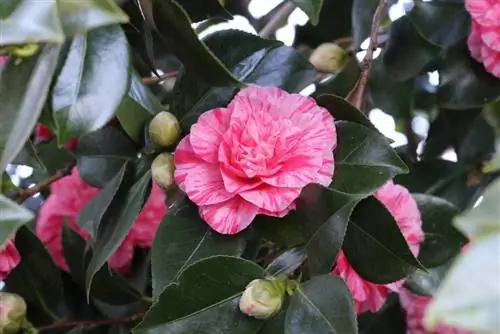
Both potted and planted camellias require a protected location. A partially shaded spot is ideal. Above all, it should be protected from cold easterly winds and winter morning sun. If the water supply is consistently guaranteed, the plants can also be placed in a sunnier location in summer. In any case, it is important to have enough light. Bright midday sun is not recommended.
- Lots of light, but no bright sun
- Partial shade is better
- Few flowers in the shade
- Protected from east wind and morning sun in winter
- High humidity
Rhododendron soil is suitable as a planting substrate. It is almost lime-free and has a low pH value, which is important for camellias. The soil should be loose, humus-rich and slightly acidic, similar to rhododendrons.
- Rhododendron soil is cheap
- Loose, humus, slightly sour
- To improve the soil, you can mix in rotted leaves, compost or pieces of bark.
- Sharp sand or lava grit improves permeability, the roots can grow better
Watering and fertilizing
Camellias are a bit tricky when it comes to watering. They neither like dryness nor wetness. Instead, the root ball should always be evenly, slightly moist. Drought causes stress and, if repeated, weakens the plants and makes them susceptible to diseases and pests. Waterlogging quickly causes the plant's fine roots to die. Rainwater is best suited for watering, as camellias do not like hard water. This water can also be used to spray the plants. Since they like higher humidity, misting is important. It should be done all year round.
- Water regularly
- Not too much and not too little
- Neither dry nor wet are favorable
- Watering is particularly important from the end of spring to autumn.
- Too little water can lead to bud loss
Tip:
It is important to water thoroughly! With potted plants, the water must penetrate the entire pot and even with planted specimens it is important that all roots get water, not just the superficial ones.
- Use rainwater
- Also for regular spraying
In order to produce lots of flowers and then open them, camellias need sufficient nutrients. This is particularly important for potted plants. Planted specimens need little or no fertilizer. A mineral long-term fertilizer is beneficial, ideally one for rhododendrons, which have very similar requirements. Alternatively, organic rhododendron fertilizer with guano is suitable. It is important not to over-fertilize the plants, they are quite sensitive to s alt. With mineral fertilizers, one dose is usually enough, with organic fertilizers you have to fertilize again.

Alternatively, normal liquid fertilizer can be used, which is added to the irrigation water every three weeks. In order not to over-fertilize the camellia, only use half the specified dose! It is absolutely important not to fertilize from the end of July onwards so that the shoots can mature until frost. If they are still in the juice, frost damage cannot be avoided. Fertilization is mainly carried out from the end of May to mid-July. During this time the flower buds for the next year are created.
- Fertilize regularly
- Rhododendron fertilizer works well
- Do not over-fertilize - very sensitive to s alt
- Fertilize mainly from the end of May to mid-July
Young plants should be repotted regularly, ideally every two years. For older plants, the spacing can be kept more generous. As soon as it is noticed that the pot ball is heavily rooted, you should change the container and substrate. The best time for this is after flowering, in May or June at the latest.
- Repot young plants every 2 years
- Older plants only when the soil has strong roots
- When planting the camellia, it is recommended to place it in the container or soil so that the upper roots are visible, i.e. not too deep. Simply plant it 3 to 5 cm higher than it was previously in the pot.
Tip:
To lower the pH value of the soil, mulching with pine needles is recommended.
Cutting camellias
Camellias are very tolerant of pruning. A cut stimulates branching, which is particularly useful for young plants. Only regular pruning will produce compact, bushy plants that bear lots of flowers. It is best to prune immediately after flowering. It is important to cut about 2 cm above the base of the leaf. The result is that the shoot dries up and not the bud in the leaf axis. If older camellias are out of shape or are simply growing too sparsely, more severe pruning can be done. This is how you influence the shape.
- Very cut-friendly
- Cut after flowering
- Especially young plants to promote branching
- Cut 2 cm above the base of the leaf
Overwintering camellias
Camellias are winter plants. They need the cold stimulus to be able to open their flowers. However, they also need protection from the cold. A thick layer of leaves on the ground above the roots is helpful here. The root ball must be prevented from freezing. In addition, the entire plant should be wrapped with an air-permeable fleece, which provides shade and at the same time keeps it warm. Choosing the right variety is crucial for ensuring that the plants survive the winter and continue to bloom. Late-flowering varieties are best. The selection is large. Camelia japonica are more suitable than the Chinese varieties, which are not suitable for our Central European winters. Plants known as Higo camellias have proven to be particularly hardy. However, they only have unfilled flowers, albeit with a cluster of yellow stamens in the middle. The flowers also have a light scent.
- Not in the heated living room
- A cold house or a slightly heated winter garden is ideal for potted plants
- Temperature maximum 15°C
- Leave outside as long as possible
- Well-rooted potted plants can tolerate temperatures down to -5°C, but only for a short time
- Cold stimulus is important for the buds to open
- If there is no ideal winter quarters, put plants back on display after the frost period
Outdoor camellias not only need protection for their roots in winter, but also from strong sun. The evergreen plants evaporate a lot of water and can no longer absorb any more due to the frozen ground. They dry up. In regions with mild winters, you can try planting camellias. There is no guarantee that they will survive the winter, but it is worth a try. As a rule, the plants can tolerate temperatures down to -12, sometimes up to -14°C. However, the foliage can freeze. Well-hardy, he althy plants grow out again. As long as the roots are he althy, the plants will recover.
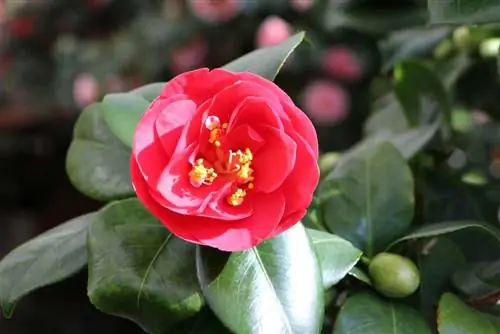
Since flowers freeze at -2 to -3 °C, it is important not to plant early-flowering varieties. If you want to keep your camellia safe over the winter, you can build a shelter for it out of slats or similar material, similar to a tent. With a tarpaulin all around or filled with leaves, the camellias can survive the cold season and can cope with darkness as long as it is cold. One advantage of this overwintering is that it delays the flowering period. This protects the buds and flowers from late frosts.
- Shade the plant (fleece) to protect it from the evergreen leaves drying out.
- Provide a protective layer on the floor
Conclusion
Camellias are beautiful flowering plants. They are not that easy to care for, but thrive well in the right location and substrate. A balanced water supply is important. The plants neither like too much nor too little water. Otherwise, they don’t require much care at all. Choosing the right variety is crucial for thriving, especially for planted camellias. The plants must be hardy and should bloom as late as possible. Early flowering varieties are extremely vulnerable to late frost. With the right selection, a protected location, suitable substrate and sufficient water, nothing stands in the way of the plants blooming.

